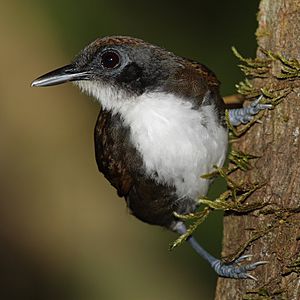Ant follower facts for kids
Imagine a special group of birds that follow swarms of army ants. These birds are called ant followers. They don't eat the ants. Instead, they catch other insects and small animals that the ants scare out of their hiding spots. It's like the ants are helping the birds find food!
Contents
What Are Ant Followers?
Ant followers are birds that get their food by staying close to large groups of army ants. When the ants move, they disturb insects and other small creatures. These creatures then try to escape, and that's when the birds swoop in to catch them.
Types of Ant Followers
Some birds are "obligate" ant followers. This means they get almost all their food this way. They really depend on the ants. Other birds are "non-obligate" ant followers. They follow ants sometimes, but they can also find food on their own.
Many different kinds of birds can be ant followers. The most famous ones are 18 species of antbirds. But you might also see thrushes, chats, ant-tanagers, cuckoos, motmots, and woodcreepers joining the ant-following party.
The Best Ant Partners
Many types of tropical ants form huge swarms. However, most of these swarms move at night or underground. Birds usually follow ants that are active during the day and move on the surface.
The most common ant species that birds follow is called Eciton burchellii. This ant lives in the Neotropical regions, which include Central and South America. Eciton burchellii is perfect for birds because it raids during the day and on the ground.
How Birds Benefit from Ants
For a long time, people thought birds ate the ants. But studies have shown this isn't true. The ants act like "beaters." They flush out insects, spiders, and even small lizards. These creatures then become easy prey for the birds.
Since Eciton burchellii is the main daytime army ant, most regular ant followers live in the Neotropical areas. However, some birds in Africa also follow driver ants, which are similar to army ants. These African ants belong to the genus Dorylus.
A Tricky Relationship
At first, some scientists thought the relationship between birds and ants was a "mutualistic" one. This means both sides would benefit. They thought the ants might benefit by having birds chase prey back towards them.
But experiments showed something different. When birds were not around, the ants actually found 30% more food! This suggests that the birds' relationship with the ants is more like "parasitism." This means the birds benefit, but the ants are harmed a little. The birds are essentially "stealing" food that the ants might have caught.
To deal with this, the ants have developed some clever behaviors. They might hide food they've caught in leaf litter. They also store food along their trails. These actions help them keep more of their prey. Some scientists even think that the birds' presence slows down the ant swarms. This might actually help other ant species that the army ants usually hunt.
Risks for Ant Followers
Even though following ants makes it easier to find food, there's a risk. These small birds can be hurt by the ants. Just four stings from fire ants can be deadly for them. So, it's a dangerous way to get a meal!
See also
 In Spanish: Ave seguidora de hormigas para niños
In Spanish: Ave seguidora de hormigas para niños


